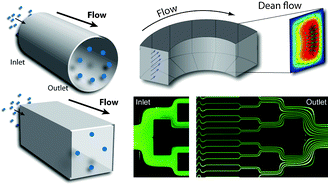Inertial microfluidics
Abstract
Despite the common wisdom that inertia does not contribute to microfluidic phenomena, recent work has shown a variety of useful effects that depend on fluid inertia for applications in enhanced

* Corresponding authors
a
Department of Bioengineering and California NanoSystems Institute, Henry Samueli School of Engineering and Applied Science, University of California, Los Angeles, CA
E-mail:
dicarlo@seas.ucla.edu
Despite the common wisdom that inertia does not contribute to microfluidic phenomena, recent work has shown a variety of useful effects that depend on fluid inertia for applications in enhanced

 Please wait while we load your content...
Something went wrong. Try again?
Please wait while we load your content...
Something went wrong. Try again?
D. Di Carlo, Lab Chip, 2009, 9, 3038 DOI: 10.1039/B912547G
To request permission to reproduce material from this article, please go to the Copyright Clearance Center request page.
If you are an author contributing to an RSC publication, you do not need to request permission provided correct acknowledgement is given.
If you are the author of this article, you do not need to request permission to reproduce figures and diagrams provided correct acknowledgement is given. If you want to reproduce the whole article in a third-party publication (excluding your thesis/dissertation for which permission is not required) please go to the Copyright Clearance Center request page.
Read more about how to correctly acknowledge RSC content.
 Fetching data from CrossRef.
Fetching data from CrossRef.
This may take some time to load.
Loading related content
